Okazaki, where the wind sweeps heavy down the plains...
At Okazaki Station I boarded my first train.
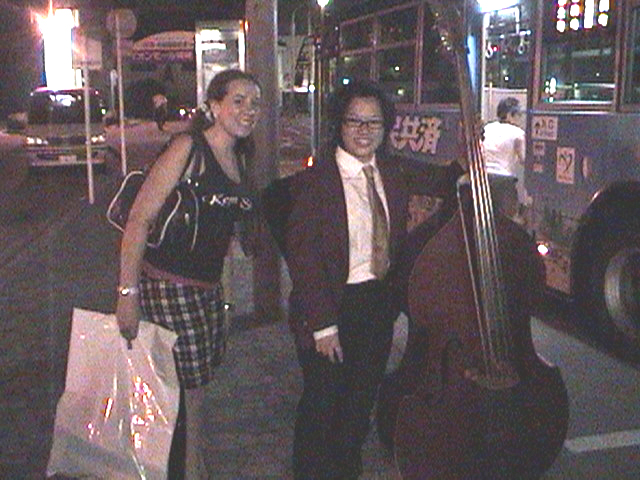
At Kota, the three of us walked a few blocks through the dark. I wanted to take pictures of every single thing I saw. Junior's apartment was the teachers' apartment. I would learn that the cookery and the books and the faulty TV and mysterious DVD player were the remnants of many teachers who had lived there. I discovered a cabinet above the sink, full of half-full and full bottles of liquor from previous residents, previous parties. Gallons of American hooch. Untouched.
I drank a bit of sake instead, near the cookery and dry goods. Junior doesn't drink that often. We all have a stake in being proud of him. He is ours.
I rediscovered my wanderlust with them that week.
In eight weeks we will have El Nuevo Presidente' dello El Estados Unidos. I wonder who it will be? 
Will it be the Multi Million dollar Manchurian Candidate, who owns the second largest Budweiser distributorship in America? Or will it be Camelot?
Four weeks ago, the farthest I'd been was Saint Louis.
I am a citizen of the world. The world tolerates me.
Chapter Two: A Namba Walk in Osaka
This is part two of my story. Above you read "Ode to Japan" which described my wanderlust and an amazing journey of a guy from Cleveland to the other side of the planet, where the culture was the opposite of shocking. What is shocking is the culture of Cleveland, Ohio, USA. The lack thereof. Shocking absence of purpose, absence of reason, absence of an economic engine based on regional cooperation. Every problem that society has, the problems that we regularly talk about in Cleveland... ALL of those problems would be eliminated and forgotten if we applied a small fraction of what the Japanese feel about their culture.
In part one's Ode, a young 50 year old fat man from Cleveland got on a Boeing 777 in Chicago. It went to Tokyo. 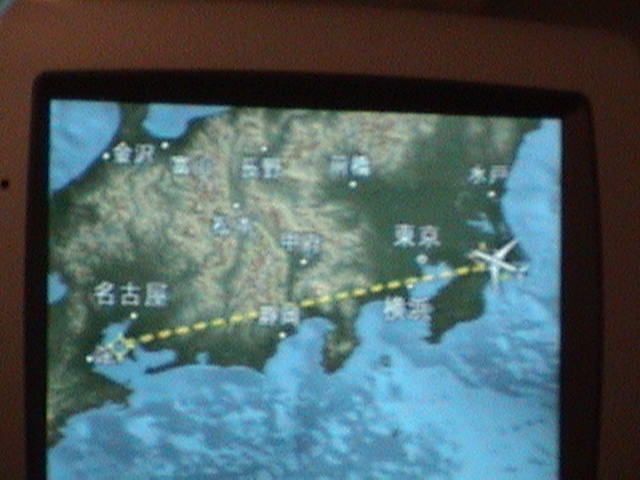
Another trip-7 to Nagoya.
Everything went like clockwork.
Once settled into the teacher's apartment, Roy Jr. drove us to a "family style" restaurant.
I pointed to the hamburger picture and asked the waitress "WHAT is THAT?"
They enjoyed my joke. The thing I miss most about Junior, with him living there, is his laugh. A great laugh.
At daybreak I woke and set up a tripod and videotaped early morning TV shows while they slept. I quietly slipped out to the porch in the blazing hot morning sun. The trees, birds, people on bicycles: ALL amazed me. And the TV shows also did. When the kids had gotten up and showered we packed smaller bags and walked to the Kota train station. We rode a small train, then got on a bigger train in Okazaki.
Our next stop was Nagoya where I activated my Japan Rail Pass. If you go to Japan, order the JR Railpass a few weeks before you go. It is a great investment.
"Dad, the train looks full. We may have to stand." It was the famous bullet train, the Shin Kan Sen. Indeed, there was nowhere to sit. We stood in the coupling area, between train cars, which is where the bathrooms and air conditioners are also located. There, a bit of the floor is flexible rubber, where the train cars meet and bend on curves. We didn't mind.
Royette's little suitcase served as a chair, and I shot video through the little windows there. A young man was standing at the door, glaring out the window. I got a very strong feeling about this guy. He was the first person we'd seen who seemed unhappy. He is on my 8mm tape, as I tried zooming past him to the countryside flying by at 180 miles per hour.
Junior had used his secret weapon: a laptop computer, to find a hotel near the train station. His weapon has the power of internet connectivity. At Osaka station we rolled our bags out to the street, where the Corona Hotel was a short walk away. On that corner, a disheveled man about my age started talking to me. We hadn't seen any disheveled people in Japan as of then.
I thought it was a homeless person asking for money. Junior talked to him a bit, and as I continued walking away ignoring him, Junior told us what he'd said: "He says the Corona Hotel is just around the corner, two more blocks." We marveled at this fact: How did he know we were looking for the Corona? It must be common for westerners to roll their airline luggage out there, looking for the Corona. Or he was a wise ninja. You couldn't see the sign "Corona" (in anglais letterage,) until you had walked right up to it.
We checked into our room. Two beds and a folded-out futon. I cranked the air conditioning. Royette freshened up into her distinctive "America-jin" clothes. The girls of Japan seemed to love Royette's look.
I was dressed like a portly America-jin tourist in brand new cargo pants.
Junior was dressed like our tour guide. A "salary-man." We rode the local train to the city, looking for the "loop" train. Imagine a graphic on all the schedule boards with feeder trains into the city (a huge city,) and an oblong train loop that stops at salient points throughout Central Osaka.
Up stair cases. Down ramps. Up ramps, down to the platform where multitudes of trainage were rolling. Two college girls walked by and Junior asked them "Which train is the one to the Namba Walk?" (in Japanese of course.)
They pointed at the green and white tram that was right there, accelerating from zero to fast. We all laughed because we just missed it. So, we had ten minutes until the next tram.
(Junior was doing what his mom described as "Flirting." A week earlier, when I picked-up my ex at our local airport, after her Japan visit, she told me about his amazing flirting capability.) One of the girls had a t-shirt that had three large English words and little flowers and happy symbols. It said "Ties. Bonds. A Yoke." Junior told her what her shirt said in English. The girls laughed really hard. They had no idea what it meant, until he explained it. I presume it meant friendship is a tie, romance is a bond, and marriage was a Yoke, like oxen labor under.
Junior asked the girls "Did you sleep through your English classes?" The one girl said "Usually," and laughed. She spoke in Japanese, but laughed in the same way we all laugh. They both laughed. We all laughed. Kids in Japan take English classes for 4 years, around sixth through twelfth grade. Junior scolded her. "You get a karate chop!" (he spoke in NiHongo-gah) and he slowly arced his flat hand like a karate "chop" down to her forehead. Laughing out loud on an Osaka train platform. Junior had told me that if you smile at Japanese folk, they will smile back. My smile looks like a slightly lesser SCOWL than I usually have.
We got the next train and de-trained at The Namba Walk. The Namba Walk includes a boardwalk along the big river through central Osaka.
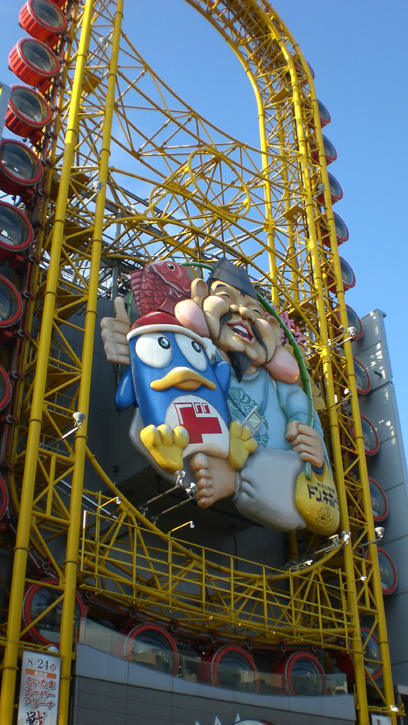
In Osaka, the river boardwalk was a valley between dozens of skyscrapers, each with 20 or 30 story electronic billboards. Junior told us that whenever Osaka's baseball team won a division or championship, drunk people would jump into the river, which was a source of illness. Years ago, Osaka won a game that had them advance to the Nippon World Series. (Chunichi Dragons are the current champs.)
The Hanchu Tigers crowd went so wild that people grabbed the statue of Colonel Sanders at the local KFC, pulled it off it's pedestal, and threw it in the river. Osaka lost, and since then it has been known as "The Curse of The Colonel." Soon after, Osaka banned people from jumping in the river after a drowning.
We walked a couple blocks, the sun was beating me down and I told Junior I was about to have heat stroke. "I'm serious, I have to sit down." Royette was happily strolling a block ahead of us. He called her back, and we bought some bottles of water from the plethora of vending machines.
We walked up a little staircase into the Osaka streets. Thousands of people were milling around. Royette and I bought pine-apple slices on a stick, for one hundred yen apiece. (One dollar.)
Delicious. The taste of pineapple, only more Japanese-er.

Every few feet there were stores, restaurants, karaoke and pachinko parlors.
Royette noticed a store-front no wider than 12 feet.
Facing the street was a rack full of Hot Wheels. "Look Dad!" she exclaimed.
I bought a couple Hot Wheels and a notepad and a calligraphy pen. It was air conditioned inside. It was a block long in depth, but narrow. It was like a Walgreens pharmacy, narrow but deep into the tall building. Junior soon found an Okonomiyaki restaurant. "You'll like this Dad."
Down some narrow stairs, (apprehensive, I was...) we sat at a steam table designed to seat four. He ordered us each an Okonomiyaki.
These two Menu Copies are courtesy www.otafuku.co.jp
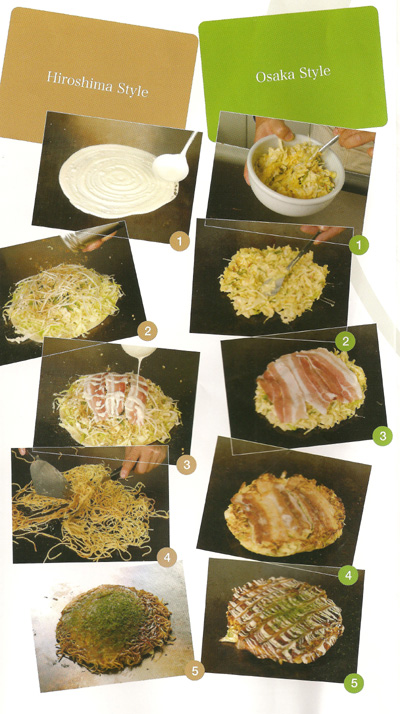
It's batter poured onto the griddle,
topped with
Hot Bonita Powder,
cabbage,
crispy tempura vegetables,
green onions,
bean sprouts,
and a choice of beef, chicken, or pork,
noodles,
egg,
topped with sauce, Osaka style.
The chefs cooked it at a bigger steam table right behind me. It was so hot outside, I think they were only firing up the booth tables enough to keep the okonamiyaki from the back-kitchen warmed. I'll bet mid-season, their chefs are at every table putting on a show.
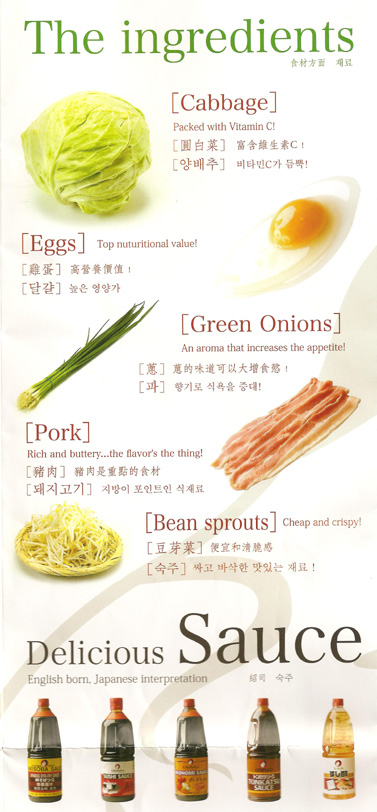
You have a little spatula and a dish. You cut a slice of the "Japanese Pizza" as we called it, and put in on your dish, and chop stick that little delicious pizza into yer tastebuds. Chopsticks at all restaurants. Forks et cetera were often available. But they are like training wheels on a bicycle. Junior had to ask for a fork for me, and we all bowed to the waitress in shame and familial embarrassment.
One order was very satisfying, even for a tourist chub from America. Cool beverages, then we went to pay the bill. "What about a tip?" I asked Junior.
In Japan, it is highly uncommon to leave a tip. "If you leave tip money, they will run after you saying "You forgot your money!" Junior explained.
We walked up the narrow stairs and walked a few blocks. We turned right and headed down the street towards the river again. At the river, there is a famous pedestrian bridge. This round bridge is one of the most famous places in Japan.
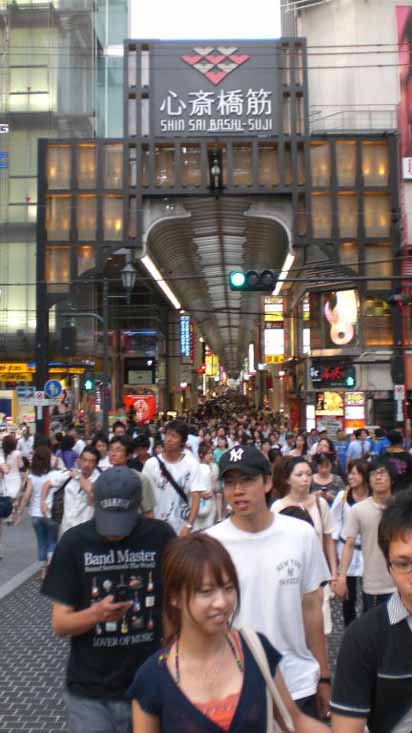
 The other side of the river is where the Shin Sai Bashi begins.
The other side of the river is where the Shin Sai Bashi begins.
It is the Inspiration for the streetscape in "Blade Runner."
I looked down the couple blocks to the bridge and I could see the Shin Sai Bashi on the other side of the river.
I saw a sea of humanity.
One hundred and twenty five million people live in Japan, the size of California. Japan is coincidentally shaped like California, only it bends the other way. It's the shape of California, mirrored on the other side of The Pacific Ocean.
I honestly believe that I could see a million people: half were walking our way, on the left side of the Shin Sai Bashi. The other 500,000 people were coming towards us on the right side of Shin Sai Bashi. At that moment, I had my first freak-out in Japan. A sea of humanity. All happy. All dressed well. Collectively spending millions of yen. All satisfied. All having expectations of luck, wealth, romance, and a national baseball championship.
The Shin Sai Bashi is a couple miles of four story buildings on each side, with a curved translucent roof arched over the sidewalks and street. This is one of the most amazing things I have ever seen in my young life of 50 years. There would only be a few dozen more astounding things to blow my mind in Japan.
We went into the Sega Arcade on the Shin Sai Bashi. Iron Claw machines are a passion of mine; Royette and I always do them wherever we see them. It's a tradition. I was unsuccessful at any of the Iron Claws of the Shin Sai Bashi. I vow to one day win a thing in a Japanese Iron Claw. Until I do, I also vow to BUY one of things I was trying to win in that arcade.
Later, Royette went into some fashion boutiques on the Shin Sai Bashi, while Junior and I waited outside on the sidewalk. At about ten o'clock, Royette was deep into one of these long narrow stores when all of the sudden, the operators of the store lowered the iron security gate, cutting the store off from the increasingly wild and happy people on the street. We freaked. "Royette! ROYETTE!" we shouted. A few minutes later Royette emerged from a little metal security door opening into the alley near the shop. She was freaking out too.

Our next destination was "America Town" on the other side of the Shin Sai Bashi. The skyscrapers at this curvy intersection feature a three story tall Statue of Liberty on top of one of the skyscrapers.
We sat on a wall at a plaza in America Town. In Mexico, they call them "PLAZA"s. Our feet hurt, but we made our way back to the river at The Namba Walk. The electronic billboards were 20-30-40 stories tall. A 30 story tall pilsner glass of beer that emptied and refilled every minute.
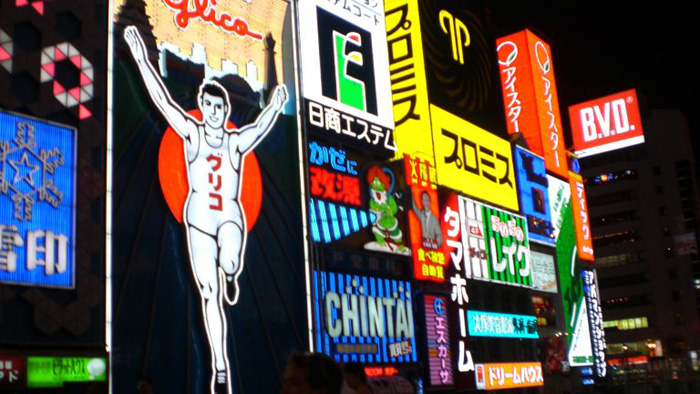
We noticed a camera crew was taping on the other side of the bridge. I deliberately walked into their live camera shot, looking dead-on into the lens, and waving a peace-sign into the camera behind the reporter with his 1970's hair cut. Then I walked down, closer to the river, doubled back up the round bridge, and did it again behind the haircut guy reporter.
Closer to the train station, we went into a Karaoke club. We did karaoke Japan-style. VERY DIFFERENT from American care-ee-okie. The word Ka ra okee means "Silent Orchestra."
Roy Junior shouted out lyrics of Japanese songs he knew, and was able to dial up all the American songs we wanted.
I did "House of The Rising Sun" of course, then "Louie Lou Ai, Oh Baby now."
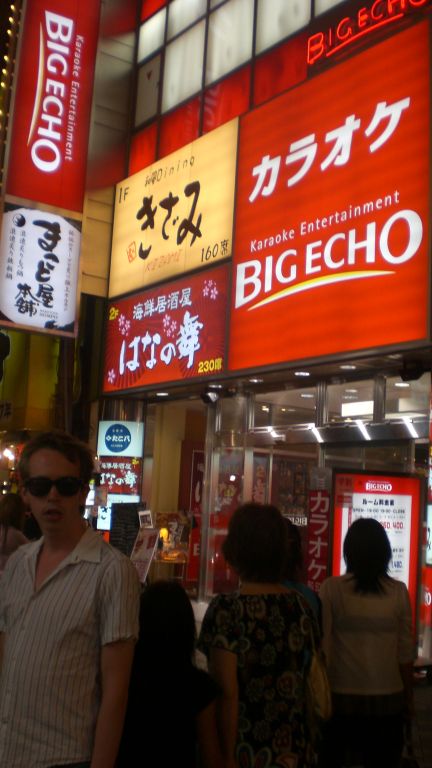
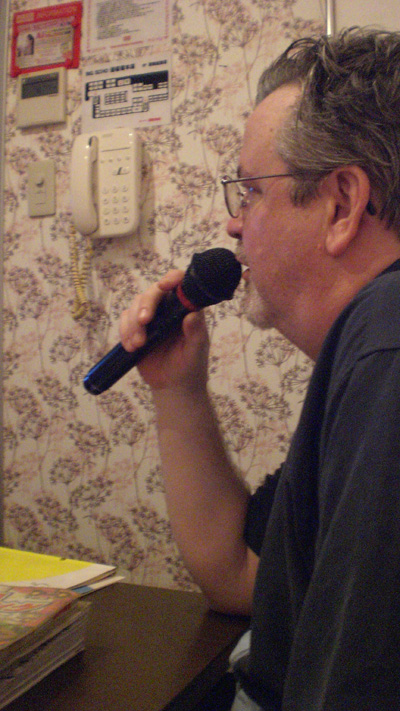

As we were leaving the club, Royette asked some "gal-u" if she could take a picture with them. They were blond haired sun-tanned Japanese gals. Gal-u. Are "Harajuku Girls" of Gwen Stefani's song considered gal-u?
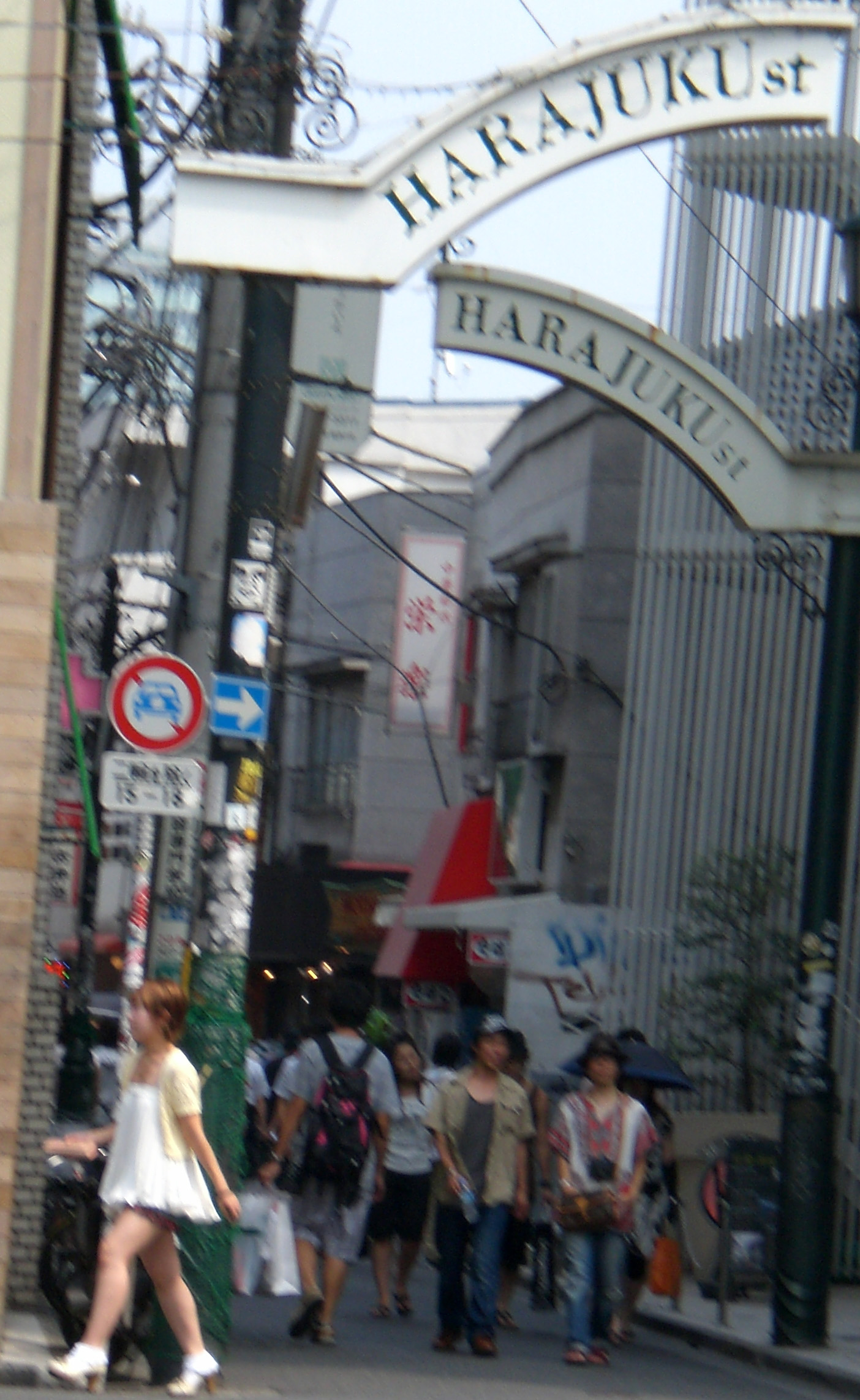
There is a house in New Orleans, called The House of The Rising Sun. In Osaka, there is a club that is actually under The Rising Sun.
Back at the hotel, the Shin Kan Sen rattled underneath our hotel window every ten minutes. The clicking clacking of the train on the rails sounded like the Japanese words I had learned. "Su Mi Ma Sen."
"Su Mi Ma Sen" At sunrise I again woke up two hours before they did. So I sipped from my bottle of sake, and wrote notes with my calligraphy pen. This then was the morning of Day Three of my walk through the island country.
Su Mi Ma Sen. Su Mi Ma Sen. clickitty clack. clickitty clack.
to briefly review
"Ode to Japan" <=== is my first day in Japan
this document ===> "A Namba Walk in Osaka" is Day Two.
Day Three: Su Mi Ma Sen
Let's take a trip from Osaka to the Genbaku Dome. This was
the hardest journey
I ever loved.
On day three of my Japan trip, I was awake at dawn... listening to the Shin Kan Sen train under our hotel window. Every ten minutes the bullet train went by, saying "Su Mi Ma Sen, Su Mi Ma Sen," to all those in earshot. I broke out my calligraphy pen and notepad, and jotted down some notes about the night before, touring the Shin Sai Bashi. I listened to music on my Sansa pod, nipped at the little bottle of Sake with the fox on the label.
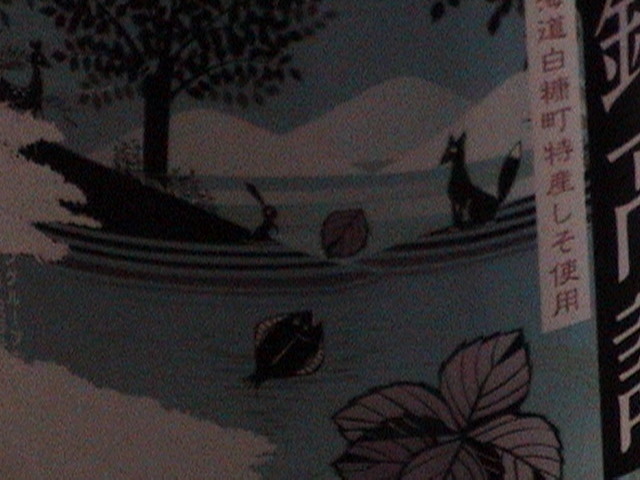
(I'd bought a couple cans of beer and the little bottle the night before, when we got back to the train station in Osaka.)
Much of the rest of my Japan trip is documented on 8mm videotape. Those tapes and still pictures the Coolroys took are critical to the experience of this adventure. What I've written about so far contains the nuanced items of my arrival and first impressions of Japan. The morning of day three, I was now able to videotape in my imitable style. All of these elements will one day be posted on a website. Underneath, you will read my literal descriptions; the pictures will flesh out the details.
At this point, however, I will step outta my travelogue mode, and state the lessons I have learned from writing about the adventure.
Roy Junior always describes his life in Japan as an adventure. I understand that now. Our visit was a venture, in which I gained alot. While it was happening, I knew it was happening. The calligraphy notes, the video and snapshots, all would help me remember about what had happened, once the happening was done. I see my writing of the adventure as a combination of these elements: Our observations. The nuance. The things that I thought all of you would enjoy reading about.
I've filled these stories with as much factual material, and nuance, and verbatim quotes as I humanly could. I feel an urgency to write these nuanced items, in case The Internet gets turned off tomorrow, by Bush or Cheney or someone. Before Cheney, we had a robust economy, budget surpluses and a free and flowing internet. The RepubliCANTs feared what Al Gore called "The Bridge to the 21st Century."
The first casualty of The Cheney Presidency was the Internet. They will only say that "the bubble burst." All the brilliant innovations suddenly went dark. RepubliCANTs didn't want anybody having fun or making money unless Corporations could do it without the college kids making a penny.
Remember "Acrophobia" and "Get the Picture?" <=== Bought by gambling websites who blew them up. You all have instances of great websites that disappeared or got sucked into bigger corporations.
The bridge to this century has been severely bombed, but we may be able to rebuild from it's skeleton.
Our room in the Osaka Corona Hotel was small, but had these features: The furniture was extremely fine polished red wood. The desk had exquisite lamps. I say again: very exquisite fixtures, unlike any cheap hotel I've ever been in. Before they woke, I took a shower in the tiny bathroom, and drew an alien face on the misted mirror with soap.
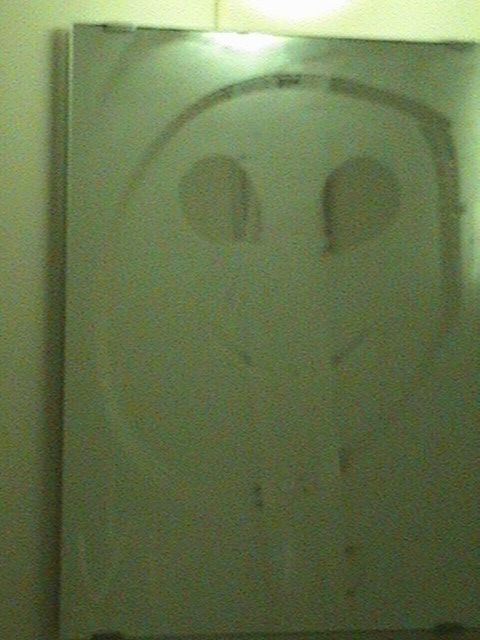
I
took pictures of the alien face, then decided it was too weird and
wiped it off. It's possible the next tenant to fog the bathroom might
have seen the alien image. I can only hope. The lobby was also appointed with very nice furniture.
Just off the lobby, there was a little room with several vending
machines. Like everywhere in Japan, they had water, tea, juice, pop, and
beer. We snagged some tea and water, then rolled our baggage out into
the blazing hot sunny day.
I can now begin to discuss civil engineering. Sidewalks throughout Japan
have these two common features. Between the roadway and lawns or
residences, there are stone tablets about two feet long and a foot wide.
Each of these tablets has an open notch a couple inches wide, for
rainwater to run into.
Beneath these tablets are rainwater conduits, maybe 6 inches of space, upon which the tablets are laid. These take runoff to bigger lower deeper channels. They are everywhere.
Another feature of every public place, every sidewalk where people congregate, is a set of yellow slabs with about six grooves oriented forward, not side-to-side. After seeing these little grooves everywhere, I asked Junior what they were. "They are for blind people." The grooves guide the blind peoples' canes. Excellent.
In Osaka Station, we grooved our way to the Japan Railpass window. Due to Junior's foresight, I'd bought Japan Railway Railpasses before we left America. Those passes got us onto a number of subways, trains, buses and even boats. This particular morning we got on the platform for the Shin Kan Sen. I whipped out my camera to take pictures of the amazing Osaka cityscape, when the bullet train pulled into the station. After 40 minutes or so, we arrived at Hiroshima..
We de-trained. I kept shooting pictures of the amazing city, the pristine train station, the ever-present recycling bins. The kids got several paces ahead of me. They headed down a long wide staircase. I was at the top of the staircase and they were already at the bottom. I was overcome with an emotion.
 After three days in Japan, with thousands of people rushing to-and-fro, catching trains, going places... a strange picture emerged. My children were at the bottom of this huge staircase. I was at the top. Nobody else was between us. Zero people were on the staircase. I took a step down and another and began crying. My conscious mind was full of amazement at the fact that this city had been leveled in exactly 63 years earlier. I was haunted. The ghosts flew up the staircase, into my soul.
After three days in Japan, with thousands of people rushing to-and-fro, catching trains, going places... a strange picture emerged. My children were at the bottom of this huge staircase. I was at the top. Nobody else was between us. Zero people were on the staircase. I took a step down and another and began crying. My conscious mind was full of amazement at the fact that this city had been leveled in exactly 63 years earlier. I was haunted. The ghosts flew up the staircase, into my soul.
I could hardly believe that these people, through a SHARED SENSE OF PURPOSE, had rebuilt such a beautiful place. Such a beautiful train station. When I got to the bottom of the staircase my face was flooded with tears, my nose was running with snot.
The Coolroys also freaked out that I was crying.
"What's wrong?" they asked.
"I can't believe it" was all I could say, sniffling. At the bottom of the staircase was the local tourist info bureau. They went in and I politely stood outside, on the train station concourse. Junior was looking into info about hotel rooms and every few minutes Royette came out to check on me. I had sunglasses on, but it was obvious I was crying. Thousands of Japanese and an occasional Westerner walked by; I didn't care if they saw me crying. They knew why. I knew they knew why.
Junior had found a hotel about three blocks away. We walked out into the sun again. It was just past noon. There was a Lawson's milk store, on the city square where the train station and bus lines all converged. I liked that. I will always like the warm friendly feeling of a Lawson's milk sign. They aren't in northeast Ohio anymore.
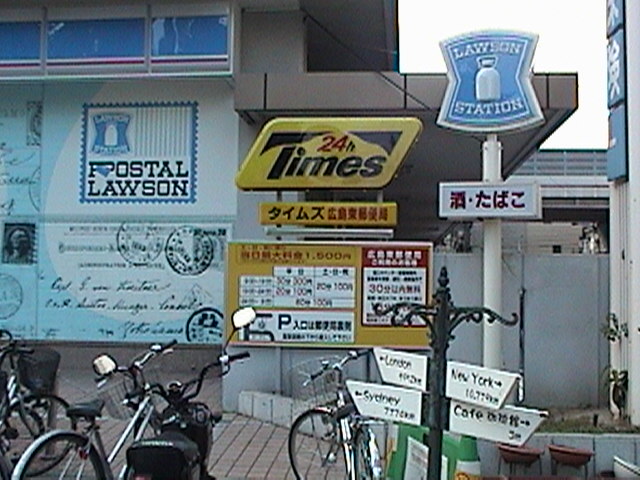
We checked into the hotel. This room was a little bigger, but configured the same. Two beds and a futon. The futon had a queenly regal headboard, so Royette called dibs on it. I cranked the air conditioner, of course. We settled down and they decided to take a short stroll, and I stayed in the a-c to cool out and collect my wits. I was embarrassed but glad that I had cried.
I did the right thing.
I became unglued in the train station for a reason. I had come half way around the planet to do that. It was cool. Within an hour, they returned. We got ready for a night on the town. The town was Hiroshima.
In Japan, the train stations seem to be the center of commerce and life in general. Imagine our shopping malls - stack ten shopping malls and have a train station at the bottom. That's a Japanese city center. We walked down some stairs and an orchestra was playing.

Royette tried her hand at videography with my camera. There were fascinating sculptures and architecture you'd never see in Cleveland, nor most of America. Roy Junior found an elevator to the restaurant area. We got on the elevator and a young couple got on with us. Junior asked them, in Japanese "Are you NINJAS?"
They laughed hard and the guy replied "Maybe we are!" The fifth floor was several restaurants in a common area; what we would call a "food court."
We got some cafeteria-style lunch and sat down by the windows. I videotaped the city scape below and ABOVE us. This is where the videotape gets good. Imagine Ten Chicagos, spreading out through several mountains and valleys. A river right below us. I zoomed into traffic, cars, motorcycles, boats. I was absolutely amazed! When we were almost done eating, I declared that I HAD TO go over to the McDonalds kiosk and get a hamburger.

I had a burger and fries at the Hiroshima McDonalds at the Hiroshima Train Station. It tasted like a McDonalds meal would taste here, only Japanese-er. We took pictures of the life-sized ceramic clown. The kids snitched some of my fries.
Escalators took us down to the high-class mall. There was an exposition center featuring "Robots" and anime characters. The toys for sale were a bit pricey, and the expo show was about 800 yen per person (eight bucks) so we didn't go in. But we could kinda see inside... it was robotic superheroes and giant cyborgs and videos.
We decided to just stroll through the mall... floor after floor. It was like several immaculate Belden Villages stacked on top of each other.
We went back to the hotel. At dusk we ventured out again. Junior got a call on his cell; a friend who had been in Hiroshima called to say he had left Hiroshima and they were sad that they had missed each other. The traffic was about six lanes wide, three in each direction. Everything was bigger and better than anything in Cleveland. Clean and full of happy productive people. I have a theory that the Japanese are expected to work hard, long hours, days or weeks at a time. Then they are REQUIRED to go have fun. Do Hobbies. Play games. Shop. Eat. Drink. Be happy. Then go back to work until the next required respite. And the city was huge, bustling, developing, expanding. Japanese and Asian and Austrailians and Westerners everywhere. We were now at huge commercial building. There, Junior found several okonomiyaki restaurants. It was now night.
Although dark, this city was still above 85 degrees fahrenheit and extremely humid.
We took the elevator up to the 6th or 7th floor. This entire floor was like a flea market, but each kiosk was a different set of okonomiyaki restaurants. No walls. Just a variety of okonomiyaki restaurants. Air conditioning was blasting, big fans blowing everywhere. 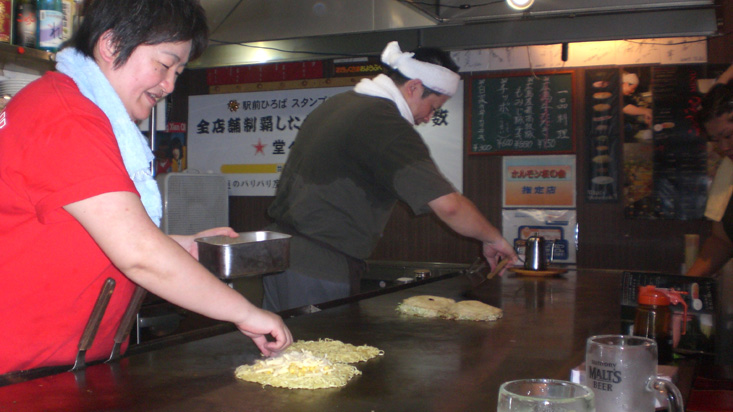 The cooks in the center, steam tables surrounding them, tables and seats farther away from the heat as well, if patrons wanted. After circling the large warehouse with maybe 20 different restaurants (some were closed for the night) we obeyed the bekoning call of a loud okonomiyaki chef. "We are the Best Okonomiyaki!"
The cooks in the center, steam tables surrounding them, tables and seats farther away from the heat as well, if patrons wanted. After circling the large warehouse with maybe 20 different restaurants (some were closed for the night) we obeyed the bekoning call of a loud okonomiyaki chef. "We are the Best Okonomiyaki!"
Ice water and beer and delicious okonomiyaki.

The basement of the building had a game room. I suffered more Iron Claw failures, we played arcade games, got candy from goofy vending machines.
Junior set me up at MY FIRST REAL PACHINKO game. The directions were in Japanese, and I dropped a couple hundred yen in the slot. The machines all had video screens with heroic, or dramatic, or monsterous creatures, or banal romantic videos.
Junior ran into a bunch of girls he knew and we took pictures in an arcade picture booth.
"Puri Kura"
You take pictures like they have at the Cedar Point arcade, then photoshop words, symbols, and mustaches on each other. Then print them out and cut them into strips so everyone has the same strip as you. Fun.

Pari Kura
Back at the hotel, I set my camera on the tripod, focused on the TV screen. A show came on that Junior interpreted as "Famous Peoples' Athletic Challenge." It was a series of comical athletic races, a tug-of-war, and similar struggles, each leading to a promise of a GRAND PRIZE of a One Thousand Yen Note (ten dollars.) We ate some odd bags o'snacks, I downed a few vending machine beers, and we went to sleep.
Next day, the Genbaku Dome.
Part Four: Atonement.
Please click this link:
http://coolroy.org/doc/ToddRundgren-Utopia-Hiroshima(live).mp3
This Song Used by the Kind Permission of Todd and Michele Rundgren
Today is Rosh Hoshana, the Day of Atonement.
What better opportunity for us to learn.
We checked out of the hotel. At the street level of the city square at the Hiroshima Train Station, we put our baggage in day lockers, like they have at Cedar Point. I wanted to take two things for the day's adventure: my camera and my tripod. Junior said "Don't bring the tripod," but I insisted. We got on a cable car. At this point, I had been on these vehicles:
1.) A small commuter jet from Cleveland to Chicago
2.) A Boeing 777 from O'Hare to Tokyo Narita
3.) A bus from Nagoya to Okazaki
4.) The small train from Okazaki to Kota
5.) The car belonging to the English school availled to Junior and the teachers
6.) The Shin Kan Sen bullet train
7.) The Osaka commuter train and the Osaka Loop train
The cable car moved slowly through downtown Hiroshima. It had multiple cars that, like the Shin Kan Sen, also had a flexible rubber floor between the sections. Unlike the Shin Kan Sen, the cars were all open among each other. As the cable car snaked through the city, the floor beneath us flexed. It was humorous. We held onto the ubiquitous thick plastic handles seen on many Japanese trains, but the flexing floor made us laugh along with the locals. The machine gripped a cable beneath the street, rode the rails, and the machine let go of the cable to stop at stations.
We got off at the Peace Park.
A short walk and we were at The Atom Bomb Dome. At one time, it was an Exposition Center for Japanese marketing and technology. Japanese products were displayed for the world... world products were displayed for the Japanese. The "Little Boy" Uranium fission bomb was dropped and exploded 600 feet above this building. It was so named because of it's much wider counterpart The "Fat Man" plutonium fusion bomb used at Nagasaki. Oddly, The Genbaku's location at Ground Zero left the structure partially intact, while everything else nearby was leveled. The dome at the center of the building folded slightly downward, shedding its roof, leaving the metal form of the dome intact.
Maybe the first atom bomb used in anger wasn't very good. Other stronger bombs were ready to be used, but that particular bomb was convenient for the United States. England didn't do it. Free France didn't do it. The other Allies didn't do it. The United States did this all on it's own militaristic volition. Why?
I set up my tripod and framed the Atom Bomb Dome. I unpaused the 8mm tape and walked into the frame. Without a good microphone, you will barely hear me say "The camera is my weapon. Its power is truth."

I picked up the camera and walked slowly around the Dome. "The Forced Marches. The Rape of Nanking. These war crimes were prosecuted. But the atom bomb was never prosecuted," I said.
The reason it was dropped on Japan was so that The Soviet Union could not shift its European force into Asia.
American newspapers falsely reported there was no radioactivity after the atom bombs. The American Media obfuscated the truth of The Atomic Bomb. The nuclear attack was done for political reasons far more than for military reasons.
Hiroshima was the higher learning center of Japan's central island of Honshu. Elementary school children would come from throughout Japan, every August, for high-school orientation. High school children were sent by Japanese parents from throughout the islands, for college orientation, every August. Hiroshima is said to have had the finest schools in Central Japan. And the children came every August. It was world renowned.
In August of 1945, in Hiroshima, thousands of Koreans were forcibly impressed into making uniforms for the Imperial Army. Thousands of Chinese and American prisoners were kept in Hiroshima, to sew uniforms. In August of 1945, 40,000 school children from across Japan were sent to Hiroshima. Some were being indoctrinated. Some worked at sewing machines.
It was as if Charon was taking tickets at a Jacobs Field baseball park, allowing 40,000 school children into the ball park, to have a ring side seat to Arma Ge Don. Or Trumann himself, dressed as a ticket-taker, with a winged lapel pin inscribed "Enola Gay." Next to the River Styx. One hundred forty thousand people were incinerated instantly. Tens of thousands suffered radiation poisoning.
In some sort of crude sense which no vulgarity, no humor, no
overstatement can quite extinguish, the physicists have known sin;
and this is a knowledge which they cannot lose.
J. Robert Oppenheimer
We crossed the bridge over the river to Peace Memorial Park. We saw ten foot tall clear-paneled cabinets with multi-color fabrics hanging from hangers.
I wondered what these colorful clothes were. Closer, I saw they were NOT garments, but thousands and thousands of folded paper cranes. (Birds.) They come from all over the world, with the artwork of school children adorning the clear lucite cabinets.There was a shrine with a bell. Adults were holding their children up to ring the bell. The ground under the bell had dozens of bottles of unopened water and tea. Royette and I walked up and rang the bell. The bell was for children. The water was for the parched victims of 63 years and three days before.
 Royette had wandered about 100 feet away; Junior and I called her back.
Royette had wandered about 100 feet away; Junior and I called her back.
We then walked along a reflecting pool, much like Washington, D.C.'s...
There: the Hiroshima museum. Admission was fifty cents.
In the lobby of the museum you'll see a clock. It runs faster whenever there is a nuclear test, by any nation. India. Pakistan. China. Russia. The United States. It runs slower when tests are less frequent. The gears of the clock are stacked from the timepiece down to the ground. If the clock speeds too quickly, the final gear is engaged; it is embedded in the ground. If the final gear is engaged, the clock stops.
 Forever.
Forever.
The first floor of the museum describes the anti-nuclear movement. Films and photos explain why. Why the United States did it. Why Trumann did it. Why the Enola Gay did it. It is child friendly. The place was packed with young adults, school children, elderly folk. There is a replica of the Atom Bomb Dome (The Genbaku) at its center.
Photo reproductions stretch from the floor to the ceiling, explaining the history and Japanese politics that led to Imperial expansion. The war crimes of the Japanese are dealt with explicitly. Potsdam. Berlin. Enola Gay. Then, a staircase up. The kids and I had been separated in the shoulder to shoulder crowds of Japanese kids, Chinese students, European and Australian tourists.
We got back together at the top of the staircase.
 This area was educational: what radioactivity is, what made up the bomb components... amazing photographs by the people who lived through it, the Americans who occupied it... the world who lamented it.
This area was educational: what radioactivity is, what made up the bomb components... amazing photographs by the people who lived through it, the Americans who occupied it... the world who lamented it.
This was evidently the original museum. Much has been added to this original building. We came to an open area, with wide windows, interactive displays, a small television show with about 50 seats, and computer learning stations.
There was a gift shop selling Peace T-Shirts, and I thought that was the end of the museum. That was only the beginning. There were several more long intertwined hallways, with dioramas of Hiroshima Before and After the bomb. There was a life-sized mock up of The Little Boy. There were melted medicine vials from local hospitals, melted eyeglasses, a melted tricycle.
One wing was strictly photographs from August 9, 1945. The mushroom cloud was photographed from venues throughout Japan. Those photos comprised a single wing. Another wing: The victims. An actual wall: photographed after the atom Bomb, and the same wall rebuilt in that room. I have a photo of the brick wall as it appeared that day,
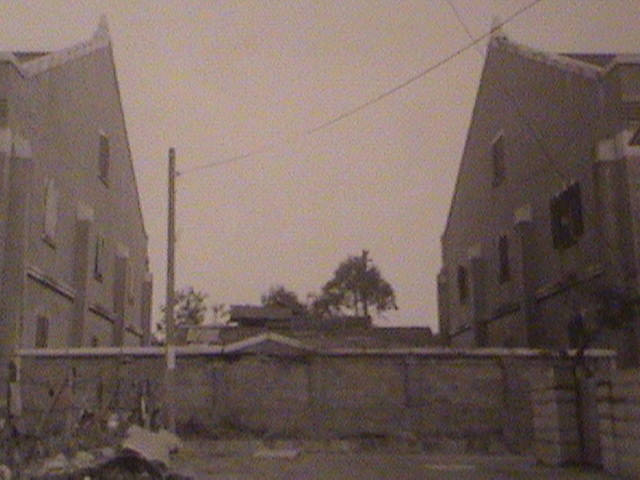
and another of Junior standing at the same actual twisted wall.The wall was at the military uniform warehouse.
The semi-spherical mound with the coarse gravel was the hallowed place in which the ashes of unidentified victims were buried. Things were starting to make sense. Scenes were coming into focus. The gravel from the burial mound was in my sweaty hair.
I had been invited by fate into the fraction of humanity that IS: The victims of nuclear devastation. We were sunburned. I was sweating. My hair was gritty.
Among hundreds of eye witness accounts, was this one, that struck me. I will type it as close to verbatim as I can.
A young man and his uncle, a farmer, had traveled out of the city to sell their vegetables. The bomb hit. This was his account, written in English on the display:
"We knew my aunt was home alone. We rushed back into the city, against the flow of people escaping. As we got to the entrance of my Uncle's home, I heard him say "Oh No!" I followed him into the devastated house. We saw the skeletal remains of my Aunt standing in the place by the kitchen window where she often stood. There was no flesh, only her bones. My uncle said "How hot you must have been!" He cupped his hands around the cheeks of her skull, and all her bones collapsed into dust on the floor."
"How hot you must have been." Those words will haunt me, until I die and then I will haunt the WAR PROFITEERS of the Military Industrial Complex. I have never repeated that TERRORIZING WAR CRIME eye witness account, until this moment. This is the first time I have repeated what I read on the wall of the Hiroshima PEACE Museum. I didn't repeat it to the kids. As I've said, it haunts me and I hope it terrifies you as well, to the point that you will never let it happen it again.
From this point, we traveled to a much happier place, Miyajima Island. Before I describe that happy place, let me smudge this TERROR into your mind. The shoreline of Miyajima, and all the delta below Hiroshima, had the bodies of thousands of victims of the blast washed up on the shore, because they jumped into the river with their bodies on fire.
Day of Atonement.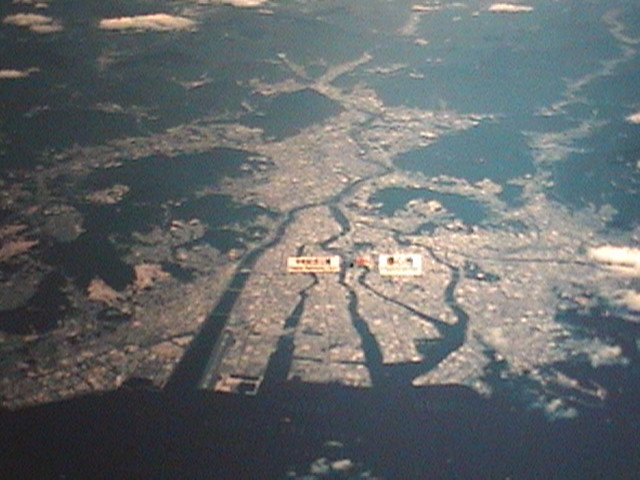
Section Five: Miyajima Island
The nearby island Miyajima is between Honshu and another of the main islands: Shikoku, to the south. Furthest south and west is one of the four main islands Kyushu. The northern most main island is Hokkaido.
The four main islands are what we know as Japan, although it includes thousands of smaller islands, such as Miyajima.
Now, back to our serial story.
In August, every year in Hiroshima, People of The World gather to lament the stupidity of nuclear holocaust, and Nazi Holocaust, and the hollow cost we've paid for hollow WAR.
The last hallway of The Hiroshima Peace Museum featured the display of the YEARLY letter from every post-war Mayor of Hiroshima, to every leader of every country, imploring them to cease Nuclear Ambition.
Then there were autograph books. My daughter wrote a little passage. Underneath hers, I wrote this misty eyed:
No One could Imagine. Not the Victors nor the Victims, Headed for Survival.
We left the Hiroshima museum, walked north along the reflecting pool, crossed the river and I took more pictures of the rubble laying around the Atom Bomb Dome.
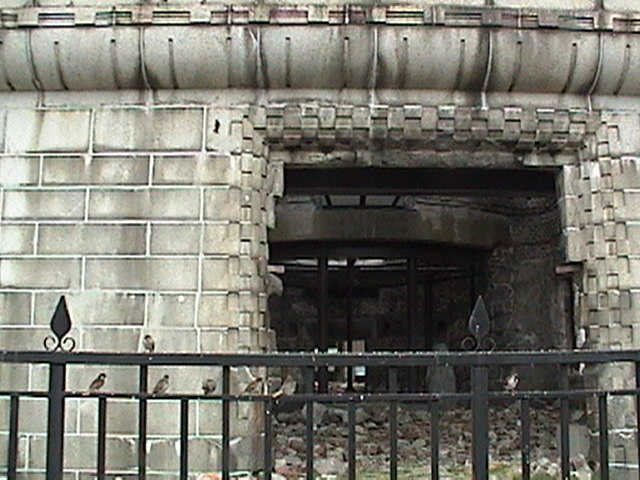
I framed three pictures the same. The third picture is significant because the only difference between picture 2 and 3 was a white bird flying UPWARD.
The three adventurers boarded a cable car in Hiroshima and the recorded helpful voices (one, a man, the other, a woman,) repeated these words: "Bing Bong."
In public places and on public transport, there are a myriad number of bells, bongs, tweets and sounders. The voice saying "bing bong" cracked us up.
At the edge of the city we walked a couple blocks to a train platform. By this time my videotapes had run out, but I could still take still pics on a memory chip. I noticed a pretty girl on the train was looking at me. For the 20 or so minutes we road the line, this girl kept looking at me. Maybe she was a student merely noticing an American tourist in Hiroshima. Every time I looked over to the girl standing facing us, where we sitting, she was looking directly into my eyes.
At the delta region, we walked through a little tourist town to the Japan Rail boat dock. After a while, a big ferry approached. It could accommodate autos on the main deck, and passengers on two upper decks. It was like the Jet Express from Sandusky to Put-In-Bay, on Middle Bass Island in Lake Erie. We hustled up the stairs to get a seat.The Coolroys (my two favorite photo subjects) were standing, while I was settling, because of my arthritic bones and ankles and knees. I noticed that the same girl from the train was right there, on the third tier of the boat. I discreetly took two pictures of the spy girl, then she disappeared.
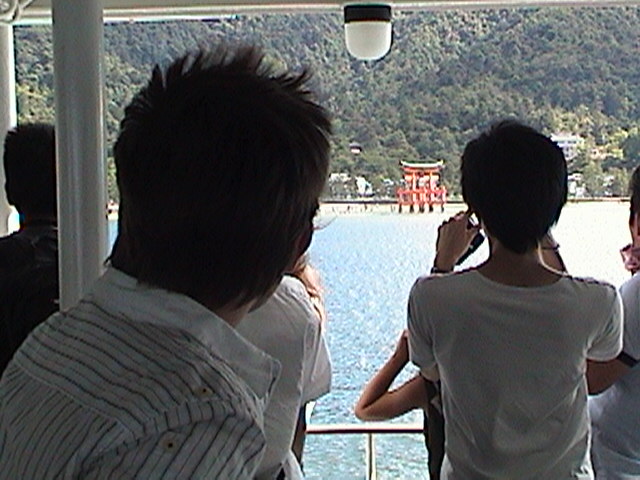
People thronged to one side of the ferry and suddenly everyone was taking pictures of the Torii (gate). You have seen it often as a symbol of Japan. The Japanese consider it one of the top three sites to visit and photograph. The Coolroys disembarked onto Miyajima Island.
The next passages are cut and pasted from
www.Japan-Guide.com
Miyajima (literally "shrine island") has been celebrated as a sacred island and one of Japan's three most scenic views. It is most famous for Itsukushima Shrine, which, together with its large wooden torii (gate), stands in the ocean during high tide.
Deer move around the island freely, and so do monkeys on top of Misen, the island's highest mountain.
The island becomes very romantic in the evening when the tourist crowds return to the mainland and only the visitors who stay overnight stroll the calm streets in their yukata and geta, enjoying the sight of the illuminated shrine.
Taki Shoji road is a gentle slope stretching from Itsukushima Shrine to Daishoin. It used to be inhabited by priests of Itsukushima Shrine, lined with the houses of "tanamori," "shokei" and "monomoshi," (three most distinguished priests who were heads of Itsukushima Shrine), in addition to the lodgings of priestesses and Daishoin priests.
This is from
http://www.miyajima-wch.jp/en/shrines.html
Gojunoto (Five-Storied Pagoda)
The Vermilion-painted Gojunoto is 27.6 meters high and is a beautiful fusion of Japanese and Chinese architectural styles. It was built in 1407, and used to enshrine a Buddhist statue.
All photos are copyright of Coolroy.org and Coolroy Productioneering, unless otherwise noted.
Again, it was brutally hot. On the island it was shady and breezy, so: not so bad. 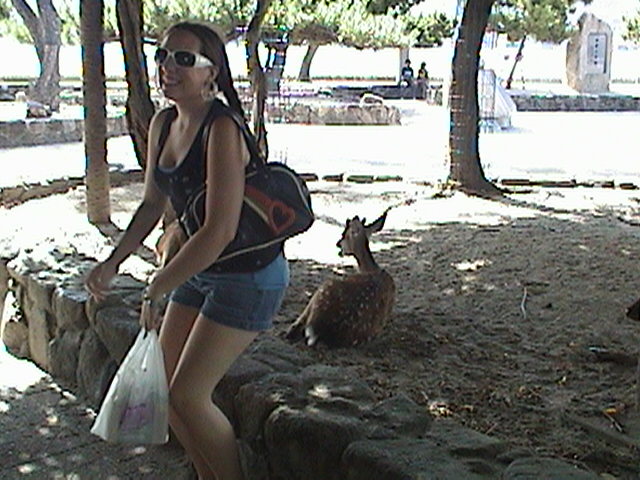
Little deer were pestering Royette for the bit of snack she had... the deer were everyweer.
Humorously mispelled
: )
On the shore we walked in the sand and Royette walked out into the tide pool to the torii-gate of the Shrine. Suddenly a very loud slow drum beat began, broadcast on a P.A. system. We walked back up into town, and found a nice quiet little restaurant. Here, I took pictures of the artwork on display.
Interesting stuff, with "Peace" as a frequent theme.
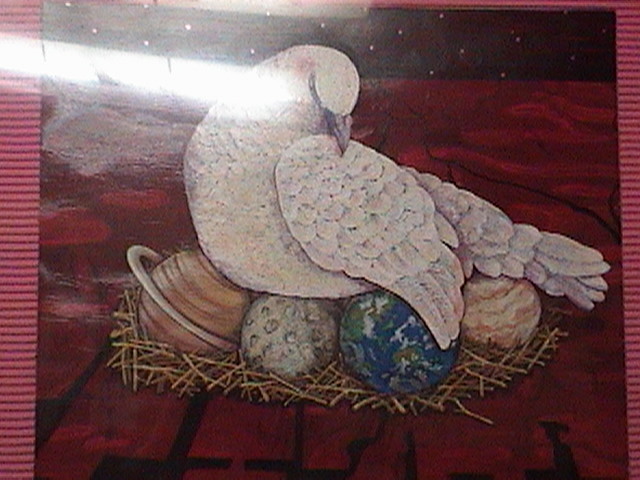
This was the farthest I had ever traveled. My niece visited China, which was a bit farther. Had any Coolroy travelled further? From Chicago to Germany in 1946? Maybe further. Dad was stationed at FurstenFeldbruck Air Base in Bavaria, in Germany.
A conversation:
"Furstenfeldbruck"
"Were you at FurstenFeldbruck?"
"Yes."
Now, back to Miyajimaguchi.
From the restaurant to the shopping street. From the shopping to the JR Ferry. From the Ferry to the mainland. From the train station to Hiroshima Station. We retrieved our baggage then to the Shin Kan Sen.
We sat three across in the front seats of our Shin Kan Sen car. We settled in, with our music pods. It was dusk and the cities of Honshu lit up and sparkled as we flew by. I dialed up an mp3 of "Mister Sparkle" and handed my earphones to Roy Junior. It is the Simpsons episode in which the electrical manufacturing conglomerate and the factory making dish soap merge and their combined logos create the image of Homer Simpson --- Misteru Sparkle-o! Junior said he would like to see the video, which I don't have. (Post Script- I have now seen the episode two years later. It is a combined fish head and lightbulb that make Mister Sparkle!)
Passengers came and went. It was a little more than three hours back to Nagoya, even by bullet train. An older Japanese man sat across from us; he had long thin hair and a long beard... a hippie of sorts. It must have been at Osaka station when half the people in the car que'd to get off the train. My kids, my progentitorship, engaged the people waiting, with "Peace" signs. Eventually everybody in the train car was laughing especially little kids. They were ecstatic, giving us a "Peace" sign back. Parents were actually encouraging their kids to give the America-jin the "Pe'easu" sign. High fives were also a required element of this INTER-CONTINENTAL cultural exchange. At Nagoya, we got on an un-crowded train to Okazaki. It was late. Junior filled us in on Japan Ball Teams:
The Chunichi Dragons were his regional team in Nagoya. Tokyo has three teams. One is near Yokohama Bay. They are called "The Bay Stars" and their logo is a smiling cartoon star. "I call them 'The Baby Stars'," Junior said. Hiroshima's team is "The Carp" and their logo is a "C" like Cincinnati's... We joked about The Carp throughout the trip.
Although late, Junior asked us to wait in Okazaki Station while he jogged two blocks to a local hotel, to check for rooms. Royette and I perused the train station artwork, and watched the young men who were there every night practicing break dancing. The three of us then rolled our baggage over to the AB Okazaki Hotel. Their logo (a large neon sign on the ten story building,) looked exactly like the "American Bandstand" logo. I called it "The American Bandstand Hotel." Royette enjoyed calling it "A Bee Hotel," but eventually resorted to calling it The American Bandstand. I stayed there the next three nights, while they went back to lil Kota-cho.
In the Bee Hotel, the television was a flat wide screen with 1125-interlaced High Definition. Their low-def is better than the United States tv standard scheduled for February 2009. Japan will slowly switch to high-def in 2011. Europe switched to high def over a FIVE YEAR PERIOD. That gave them time to work out bugs. Idiots in Washington, D.C. obeyed their CORPORATE OVERLORDS and decided to screw the American people into a crappy format. Democrats and RepubliCunts are equally responsible for this. And, oh yeah, the digital broadcasts wont go the distance of our current analog signals. Brilliant.
The European high-def can be picked up in tunnels and mountains. Not ours. Philo Farnsworth's brilliant invention, the center of American Culture, has been thrown into the trash heap of history. Suh Me Mah Sen. (Post Script, 2 years later: The US is now all digital TV. I can hardly pick up any of the local stations. The signals are 50% or less. Scammed. Billions of dollars of working equipment was rendered useless at the same time billions went overseas for new lousy equipment.)
A few more interesting notes about the Bee Bandstand Hotel.
At the hotel's check in desk, Junior translated, and I was invited to put my credit card into a little machine in the lobby. As soon as I did, a credit card sized flexible metal card spit out of the machine with my name "Coolroy" laser imprinted on it. The metallized card had two functions.
1.) Open the door.
2.) The room was silent and dark, until Royette noticed an angled slot just inside the door that said "Insert card here" As soon as I put the card in the 2nd slot, THE LIGHTS CAME ON and the air conditioning came on. I had to manually turn on the refrigerator. We double checked this: I pulled the metal card out and the lights, a.c., and refrigerator turned off. Brilliant.
I had to learn the Kanji to know how to operate the air conditioning. I have since forgotten them.
Junir pledged to pick me up by car the next morning, and they left for Kota-cho. I went to the lobby and bought three cans of beer, and two bottles of tea. I went back to the room, re-turned on the lights; re-turned on the air conditioning; re-turned on the refrigerator. I settled in. I put a fresh tape in my camera. (Everything had been in the day-locker in Hiroshima.) I put the camera on the tripod. I videotaped the 2008 Olympics and wonderfully interesting Japanese television shows. Most of the 5 hours of tape I brought back to America was Japanese television. The cultural learning came in bits and pieces. The television came in long fascinating tape rolls. I woke at sunrise. I showered and dressed. Pulled my metal card outta the slot. Elevator to the lobby.
The AB Hotel had a free breakfast. Interesting bread (not like here,) interesting salad: cabbage and mayo packs, tomato-paste packs, lil sausages (no eggs) and a soup station. The soup kettle yielded a salty, shredded veggie soup. Miso?
I put a little bit of each on my cafeteria tray. There was a LARGE TV on the wall, with Olympic highlights being shown on a program like NBC's "Today" show. The only difference is that in Japan, they Call NBC "NHK." Many TV shows in Japan also included a small insert picture of the show-hosts reacting to the story. American TV will copy the idea soon.
Looking out the window, the biggest thing in front of us was the Okazaki Station.
Okazaki, where the wind sweeps heavy o'er the Plains!
Junior drove the English school automobile up to Okazaki, to pick me up.
Pre-Epilogue: Kota and The Chunichi Dragons
After four days traveling Japan, we rested. Junior had actually been our unpaid tour guide for almost twenty days. JoRoy arrived in Kota while Junior did a week of teaching English at the School of the teaching of English by Williams-san.
Junior's friends, co-workers and neighbors showed JoRoy the tea ceremonies, mountains and shores of Japan. My daughter and ex-wife were supposed to overlap a few days, but a once-in-a-century storm hit Chicago and O'Hare airport was shut down. They overlapped only a few hours.
If you use Travelocity, don't bother paying the extra $25 for insurance like I did. Like every other form of insurance, if you make a legitimate claim about the coverage the insurance company promises, they will NOT honor their coverage. Our vacation, two years in planning, was turned into an emotional roller coaster, with Royette stranded at O'Hare. Buying the extra insurance coverage became another premium along with the highest-ever jet fuel costs, and the thousands of people who ramped up demand for plane tickets in late July and early August as they headed for Tokyo, because the air pollution in Beijing would have killed them during the Olympics.
My daughter and I overlapped a week. By then, The English School was on summer break. Early August has the hottest weather sizzling over Japan. As you read earlier, the students of Japan visit their prospective NEXT school with their parents in early August. If you are planning to atom bomb the School Children of Japan, early August is the perfect time!
So, on the fifth day, Junior rested. I was awake at dawn, as I had been each day so far. No jet lag. Excitement. Junior drove from Kota to Okazaki, and picked me up at the train station. I got to experience Japanese traffic. I asked Junior if he knew of any electronic stores, because I was out of videotape. He was pretty sure he knew one, but it would be later in the day.
In Kota-cho, he pointed out a sign that said "English School" in English. At the intersection, he mumbled, "what's going on there?" There were people having a barbeque lunch party across the street. I didn't realize until I was back in the States, that the barbeque was probably his co-workers. A Teacher's "In-House Day" off school.
A few weeks after returning, Junior's mom asked me how I liked the barbeque they had at the school. Uh... umm...
I realized we had missed it. Things spun faster and beyond our control, and the sense of loss scarred us. The three of us may have missed a luncheon in Kota... but I'm not sad about that. I feel a sense of loss for what Junior left behind: the comfortable apartment in Kota, his friends from the bar in Kota, his co-workers now breaking-in new English teachers, as they have no-doubt done year after year.
We planned to "chill" in Kota that afternoon. They logged onto the infra-web of MyFriendsterSpaceFaceChatBook.
I stretched out on the couch and got a strong hit of jet lag.
I half-slept with wonderful vivid dream-lettes broken only by my profound sweating, and wiping my forehead with my hand towel, which I had grown accustomed to carrying with me. I saw people all over Japan, wiping their foreheads with little wash cloths, both men and women, so I carried one as well, by now. In the couple of hours I half-slept, they were laughing hysterically at stuff on You Tube or whatever site. When I was done sleeping, I rolled off the couch onto the floor.
We decided to take a walk to the local grocery store. We left the apartment and walked across a narrow bridge over the big storm water ditch near the apartment buildings. We walked up a new street, where new houses, condos and apartments were being built. I had an intense Deja-Vu of walking from the seashore of Sea Isle City, off the coast of New Jersey, to the store in Jersey were the island people shopped. When there is one store in town, that's kinda like a social gathering place. During a family vacation in Sea Isle City, President Johnson was meeting with Vietnamese and European emissaries to end the Viet Nam War, in New Jersey. Unfortunately Nixon got elected in 1968, so the military industrial complex bombed-on. When my brothers and I walked to the Jersey island's store, the locals were talking about the Big Rumble that was gonna happen that weekend. A Rumble is a anachronistic fight between rival youth gangs.
In August 2008, we got to the major road, and carefully walked several more blocks. We found the Kota Shrine. Beautiful piney trees and gravel paths converged at an area with amazing stone sculptures, devotional placards and plaques, and an old wooden temple. It was open. No walls. No people. I bowed deeply and said my self-created Christian prayer, to myself:
Dear Lord, thank you for all the beautiful things you put in the world, and thank you for all the beautiful things that came my way. You are The Lord and creator of my life. Let me be a part of the Good, not part of the bad. Help me spread the Good.
Sometimes I add these lines from the Catholic Consecration:
Let your Spirit come upon these gifts.
("Clement, Cleetus, Sixtus and Aurelius, Damien and Crosaganous.") I don't think they say that part out loud anymore. Dunno. Haven't been to church in decades.
We each bowed with our silent thoughts, then walked a few more blocks to the store.
The shopping carts were tiny - half the size of ours, like a large hand-held basket, but with wheels. "Don't use a cart Dad, you'll look like an old lady!" I didn't care. I used the cart. A room-sized section just inside the building had beer, wine and liquor. I spent at least 10 minutes in there while they shopped elsewhere. I picked up a couple kinds of beer (judiciously the biggest cans for the cheapest price) and a couple bottles of Sake. I would have bought 20 bottles, one each, but settled on one with a cool paint-on-glass label, and another one like in the kitchen in Junior's apartment. The cashier and I discovered we had exactly ZERO words in common. I realized she wanted me to pay immediately. I kinda wanted to keep looking, but she seemed insistent that I pay up. She was older, and seemed wierded-out by an American Gai-jin buying her liquor. She had other work to do.
I rolled up and down the food aisles quickly. I picked up a couple little fresh fruits and fruity drinks, but there was TONS of stuff that was bizarre in bizarre packages. The kids were about done, but I was being a pain. Like an old lady, maybe?
I noticed some humorous dry-good things that would be good souveniers, and tried to find blank eight millimeter video. No luck. No VHS, no tape. Only digital media.
On the way back to the apartment, we went into a littler store like a 7-11, where Junior was pretty sure he could buy tickets for a baseball game. The Chunichi Dragons were playing that night, and the next. We got ticket vouchers from a little computer vending machine for the next night's game. One of Junior's students happened to be there with his mom. His mom wanted him to meet Junior's sister and dad. This kid looked at me with such amazement in his eyes as we shook hands. He couldn't believe that his respected Junior-Sama had an Older Sama. The kid's mom was loving this moment. Then back to the apartment. We put a few things in the little fridge, then got in the little car. We headed for Miyakawa Bay. It is the crab shaped part of Aichi Prefecture.
About 15 minutes through the countryside, then a tourist area near the shore. Junior announced that he was going to do a "Tokyo Drift." He tried to make the little car slide sideways but all it did was hunker down on its suspension. While stopped in traffic I saw four young adults: 2 men, 2 women, walking from their car into a restaurant. They were all looking at us, Westerners in their town. I flashed them a Peace Sign and yelled "Peeeeace" They flipped out and they all Peace Signed us back, yelling "Peeeace."
"Well done, Dad." Junior said. At the intersection of Fukouzunakaikeda, we went into a sushi restaurant.
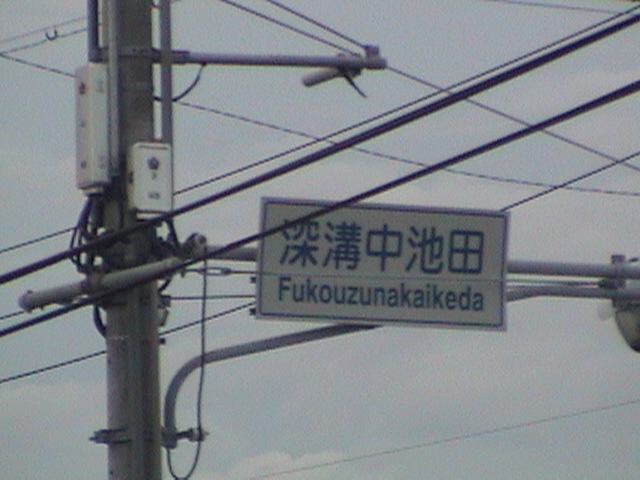
The center of the place was the kitchen. Around the cooks was a constantly moving track, with an irregular shape. Each bit of space was efficiently used. Around the track were counters and seats. The bending moving track had "Hello Kitty" illustrations on it. Each seat was a wooden stool, one square foot in area. I sat elbow-to-elbow with an old woman on my right and Royette on my left. We each had a ceramic tumbler and a hot water spiggot. A couple tiny spoonfuls of powdered tea, then hot water made the most delicious tea I have ever had. Junior described the dishes that were rolling by. He alerted us to the tuna. The cook directly in front of us was glazing the tuna skin (still attached) with a little blow torch. Delicious.
You may be familiar with sushi, but this was my first experience with it. Although reticent, I loved it and stacked up about a dozen little plates. They charge by the color and quantity of your plates. I finished with a few crispy chicken wings. Not like chicken wings in America. Amazing stuff.
Back in the car, we got to the seaside village. We pulled into a parking lot. A big store. They had blank 8 millimeter tape. Arrigato Junior-san. I wanted to buy one of everything I saw in there, too, but settled on a few blank tapes. Then, to the shore. A beautiful park. Terraced walls down to the shore.
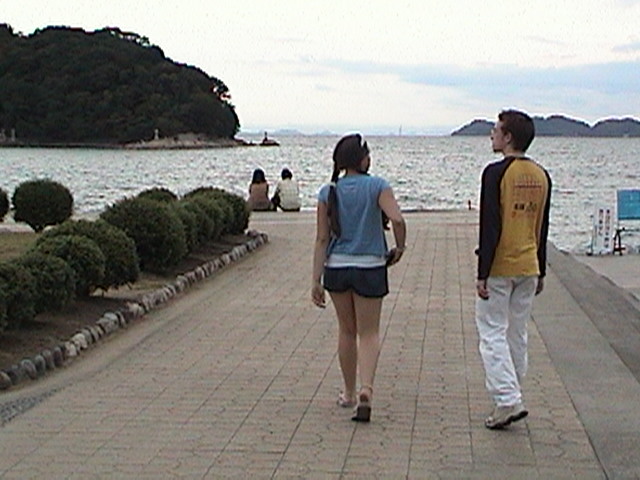
The surf was small, lapping up onto the beach. People were all around. It was the only time during my trip that the sky was overcast. I practiced zooming into the moon, then out to the entire beach. Then zoomed back to the moon. It was almost a full moon. There was a very long pedestrian bridge to an island in Miyakawa Bay. A young couple was walking ahead of us, with a small child who had an oxygen tank. The child was obviously ill. The island was a complex of shrines and temples. I took the Shorter (longer) staircase, Straight up the mountain; The kids took the long way around the island until we met up on the opposite side.
I took some pictures. Royette took a ton of great pictures here as well. I will post all of this on the new website "Coolroy.org" soon.

Across the bridge again, to the shore... it was dusk. Brazilian Japanese were camped out at various spots on the shore, barbequeing and drinking beer. Young people came and went. We hung out until dark, talking and drinking bottles of tea, juice, and water. I collected all the empty bottles that had filled the back of Junior's car, and dutifully put them in the park's recycle bins. I was being part of the Good, not part of the Bad. We drove through the resort town at night. The biggest thing in the area was the Dog Track. It was obviously the center of activity, but ringed by tons of night spots, restaurants, motels. Roy Junior got kind of lost winding around little side streets into the country-side, eventually finding the main road back to Kota.
Back in Kota we watched a few episodes of "Flight of the Conchords" the HBO show about the New Zealander musicians in New York City. The DVD's wouldn't play on the machine native to the apartment; We hooked up Rayette's portable player and we were good to go!
Then Junior drove me back to the Okazaki American Bandstand Hotel. He left and I watched high definition TV and Olympics coverage. It was as if I was on vacation. The air conditioner mounted on the ceiling had a little remote control. I struggled with the kanji symbols to get it to both cool and oscillate. I slept like a baby, until dawn. The hotel had a complimentary breakfast. The first and third day, the meal featured little sausagey wieners. The second day, I dunno what the meat was. Bread and jam, salty soup, coffee, orange juice and tea. The guests were all watching NHK (NBC Today Show style) coverage of the Olympics on the big high def TV. Train station workers, construction guys, service girls in uniform enjoyed breakfast with the funny round-eyed, round-bellied American-jin. I frequently crossed paths with the attractive lady hotel manager. She seemed to enjoy seeing me each of the three mornings. While waiting for the kids, I logged onto a computer in the hotel lobby and typed in "CNN.com" I took screen shots of the top stories. I used the lobby phone to call Roy Junior. That was a major accomplishment of which I was immensely proud. I decided to travel light this last full day in Japan: my camera without the tripod. For days, I had been using a big thick scratchy neck-strap to hold the camera. This particular morning, I switched to a light, thin cloth strap with the words "NABET-CWA" printed up and down on it. Members of the National Association of Broadcast Engineers and Technicians,Communication Workers of America use these straps to hold their ID badges. It was perfect for what I intended.
Instead of driving, my kids rode the little train from Kota to Okazaki. We got on the JR train to Japan's second largest city, Nagoya.
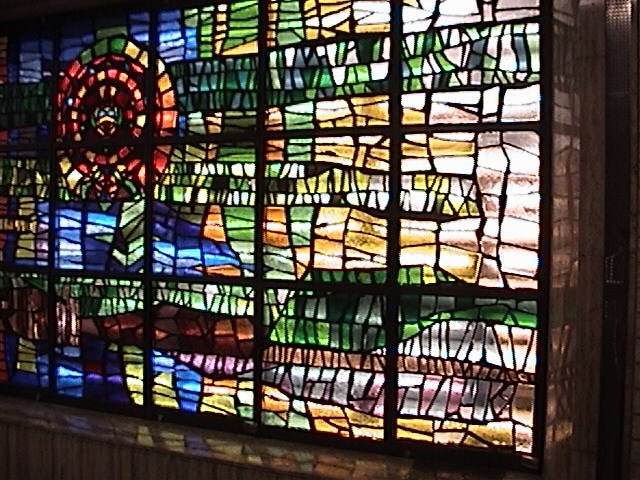 The Nagoya train station seemed to have a lot of Christian imagery such as stained-glass windows.
The Nagoya train station seemed to have a lot of Christian imagery such as stained-glass windows.
I saw a girl with a shirt that said this on the back:
"What you are
Is God's gift to you.
What you make of it
is your gift to God."
I tried to snap a picture of her shirt, but it was blurry, since everyone was walking.
We emerged at the center of downtown Nagoya. Here, a three story shopping mall, open in the middle. The open area was about a football field in size. The three stories of stores wrapped around this open area. The roof was a plexiglass football field sized pool of water, a foot deep. We took an elevator to the top, and walked the circumference of this amazing clear roof. At night they project colored lights on the watery roof. Back on the ground floor, we ventured into some stores.
First we went into the NHK store. It featured items of all kinds, related to NHK TV characters. I was thrilled to find Hot Wheel sized NHK vehicles. The place was buzzing with hundreds of people seeking items from the newest show on NHK from the creators of the animated "Swept Away."
Next
to it was a store of "Dragon Ball Z" teenager type merchandise. Across
the way was The Nagoya Pokemon Store. We took our life into our hands
and entered the Pokemon Store packed with wall-to-wall little kids and
parents. I was unable to find any of my favorite Pokemon: Bulbasaur. The
kids told me that was Sooooooo five years ago. Not like the cool new Pokemon kid friendly stuff. That place was insane. We could hardly move. We left that open park-area and went into some long underground hallways with every high-end department store, Starbucks, news-stands and such. It was a myriad of underground catacombs under the downtown streets. We went back up to street level. Junior said "Hey, the temperature sign says it's 35 degrees Celsius. That's like 105 Fahrenheit!" It felt like it. Humid.
We found an Italian restaurant, had lunch in the air conditioning. "I Love My Pasta" Junior said. Back to the mall/train station to kill an hour or so before the baseball game. After walking and walking, we had to sit down and found a long, tiny restaurant featuring cheesecake. The conversation evolved into a discussion of something about GreenSplah High School. We were hysterical. Every other person in the long thin restaurant was a fashion-conscious beautiful Japanese girl. "Splah!" as Amy from Futurama would say.
Back out to downtown, for a mercifully air-conditioned visit to a Starbucks. I have never spent even one minute in a Starbucks in America, but we spent about an hour in this one. Then, a short train ride to the Nagoya Dome.
It was about 6 in the evening and hot as blue blazes. A long walk up a long, circular staircase, and we could see the Nagoya Dome. Now we only had to walk about another quarter mile to the ballpark itself. When we got there, people had kiosks and booths and tons of free stuff. We got in the Dome and IT WAS AIR CONDITIONED! It seats about 40,000 like here, but it was immaculately clean and IT WAS AIR CONDITIONED! I was in Heaven. The terraced levels were polished stone. You could eat off them. I saw a kid spill popcorn and try to pick it up and eat it, but his mom politely knocked it outta his hand. So, even though you COULD eat off it, they weren't. Did I mentioned this 40,000 seat stadium was air conditioned?
We walked up to the third base line during batting practice. A beer vendor sold me a beer. We meandered around the entire place until we found our seats---the very top corner next to the scoreboard. The scoreboard was bigger than some of the hotels we'd been in.

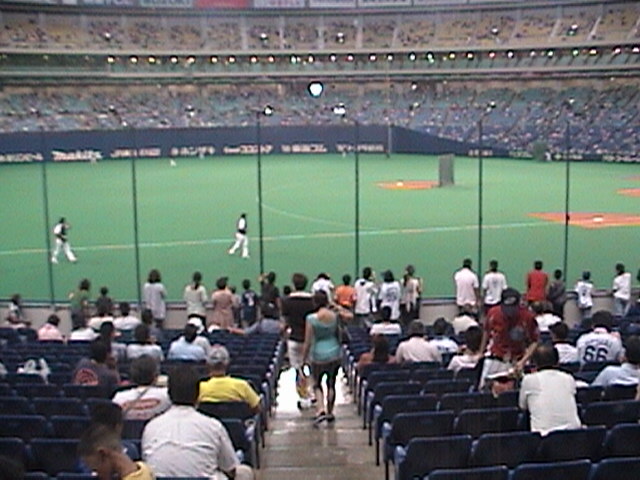
About 2000 people were in a cheering section. There was a full orchestra. Chanting, singing, pounding drums and noisemakers. No words can describe the atmosphere. We ate popcorn and junk food and real food and I enjoyed a few beers. The Swallows got ahead of The Dragons by one run, and we maneuvered to the cheering section on the First Base Line. We decided to leave in the 8th inning, to beat the rush to the trains, unless The Dragons tied it up. They never scored a run, that we saw. We left before the ninth inning. As we walked outside the building, I was rolling videotape.
Junior says on the 8mm videotape "Dad, is there anything else you want to do before you leave Japan?" At that moment I let go of the camera, thinking it would swing from my neck strap to my side. But the strap let go and the camera hit the pavement hard, breaking the video head. I had shot five hours of tape around Japan. Now my trusty camera was mortally wounded. I could still use it for still pictures, but the subsequent recordings had bands of no-info in the frame. We went down the circular staircase to the train station.
The subway train was packed like sardines. So many people. More packed than The Pokemon Store. The three of us were standing. I was trying to hold a plastic handle, like everywhere else, but to be polite, I let older folks and ladies take my handle. I was standing in front of a young man sitting on the bench. He looked sleepy, passed out. Dozens of women and even a long haired MAN were wearing elaborate beautiful Kimono. As the train slowed into a station, people lurched bumping into each other. It was kinda funny. Suddenly the young drunk man stood up to push through the people to get off the train. I didn't see what actually happened, but here is what my kids saw:
The young man had a phone, or hand held blackberry device, or I-Pod or whatever. He held it up to his mouth. As the train lurched to a stop he spewed vomit. The vomit cascaded OVER his I-Pod in an UPWARD direction, drenching everyone around me with horrible vomitous spittle. A LOT of vomit. The dude ran outta the train car. People starting moaning and politely complaining in Japanese. I was puzzled.
What just happened? I thought. I noticed everyone around me was squeezing back, squeezing away from me. A few little kids with Chunichi Dragons hats and shirts were looking at me, laughing. I looked down and saw vomit all around me. As the train started up again, my shoes began to slide into the horrible puke zone. A man and his wife, standing shoulder-to-shoulder with me, were completely drenched in vomit. He was quietly moaning. There were chunks of something resembling diced pineapple all over his shirt. His wife was beginning to cry.
I now fully understood what had just happened. I pulled my wash towel out of my pocket and started wiping the vomit blobs off the guy, onto the floor where we were ALL sliding now. We were face to face and he repeated "Arrigato. Arrigato. Arrigato Goyzaimas!" His wife repeated it also. They couldn't believe that a total stranger was using his clean wash cloth to aid them in this moment of reverse-parastalsis crisis. I was trying to be part of the GOOD. It was all we could do not NOT fall down into the slippery peptic acid. The precious little air that was in the train car was now only foulness. The train was now moving at full speed. People were moaning En Masse.
I saw my kids squished into a human mass about five people-deep, away from me. They were wide-eyed.
I looked down and saw upchuck goo on my brand new cargo pants.
"I'm HIT!" I yelled to Junior. Those were the only two words I could think of.
Junior shouted "Get off at the next stop!" At the next stop people crowded the door and we couldn't get off in time, even though we were right by the door. "DAD! DON'T GET OFF!" Junior yelled. I grimmaced and stood my ground against the flow of horrified, puked upon passengers. The train lurched into gear again and I stood there sliding back and forth in someone's alcohol+fish+pineapple EXCESS. We got off at the next stop. The train platform was eerily empty except for my two beautiful kids and me, with puke on on my pants.
"Dad, you have to tell the story of what just happened on videotape." Even though the camera wasn't recording properly, it DID record me. I stood on the eerily empty train platform and described the events that had just transpired. We got on the next train, which was not crowded. It eventually landed us at the Okazaki Station. We went back to my hotel room, laughed and commiserated.
"Tonight, you have experienced a truly unique Japanese experience," Junior Walton Coolroy awarded me.
The next day Royette and I left Japan for America. The sports section of the complimentary airline Tokyo newspaper held no clue in English as to the score of the previous night's Dragons/Swallows baseball game. If the Dragons came back to win, I will never know. The Dragons made the post season, I saw on the the infra-blogasphere.
There will be an Epilogue to these stories. All these will one day be posted on Coolroy.org
The video will be edited; It's epilogue will have odd un-recorded lines encroaching on the left half of the screen, where the shattered video head could no longer write.The shattered ceramic shell, around its magnetic core, no longer able to create the "head gap" necessary for a magnetic pulse to reach a few microns from the hardware to the moving band of mylar, coated with iron oxide. I can't feel sad about that. We did so much, in so little time.
Coda
What we did, we had to do. It was our destiny to go, to be amazed, to eat and drink, to sweat, to ride the rails, for better or for worse. No force could prevent that magic from happening.
I knew it was happening when it was happening. We took some pictures. We recorded some sounds. The Earth kept turning, in the manner and direction that it always had before and since, and I thank God that all those beautiful things came my way. But things started spinning slower and slower, and fell WITHIN our control, and healed all the wounds where we had once been scarred.
To Japan, so much is owed.
Ode to Japan.
Seven Years Hence... updated August 9 2015, 70 years after Nagasaki.



